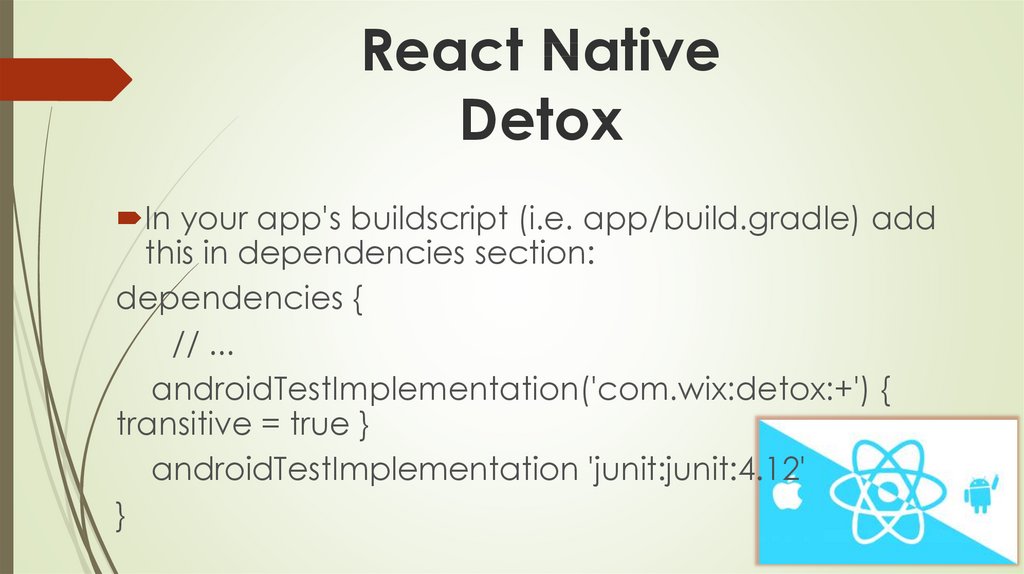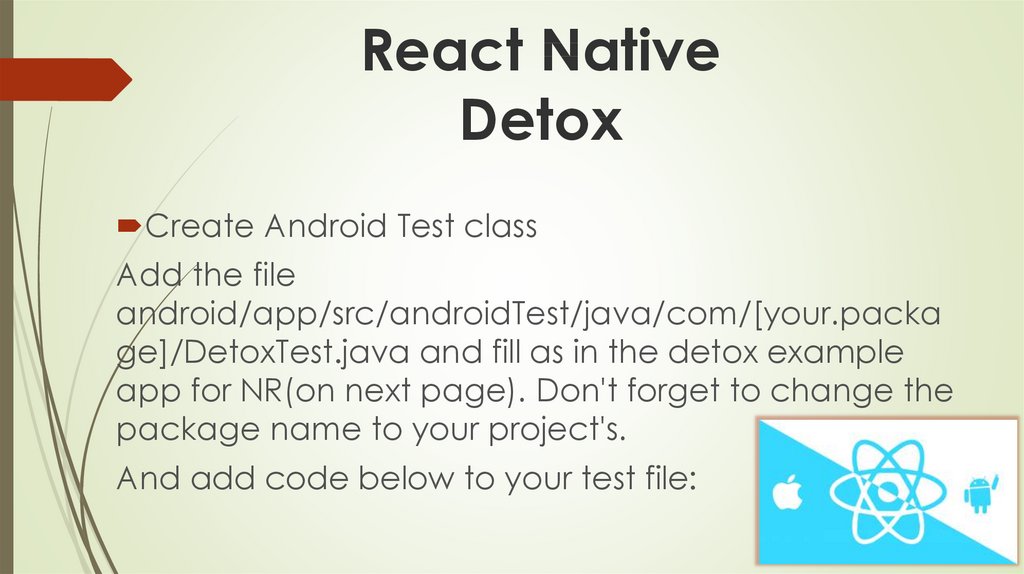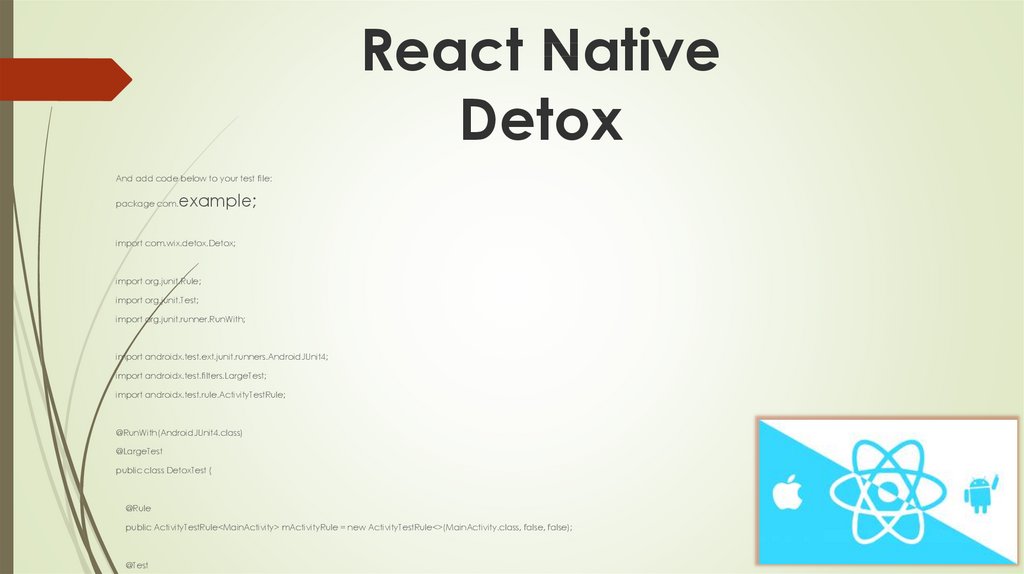Similar presentations:
React Native UNIT test, TDD, JEST and DETOX
1. React Native UNIT test, TDD, JEST and DETOX
DEV {Education}Преподаватель –Эльмар Гусейнов
2. React Native
UNIT TEST is :software testing method by which individual
units of source code, sets of one or more
computer program modules together with
associated control data, usage procedures, and
operating procedures, are tested to determine
whether they are fit for use.
3. React Native
When possible without UNIT TESTthe project is not complicated. The application is placed on several screens (1-5-10),
there is no complex logic, just text and media files
the project is not long-playing. The project is made to order, the lead time is short, you
will not need support or adding new functionality
you have developers who never make mistakes :)
In other cases, it is desirable to cover the code with tests.
4. React Native
Advantages of UNIT TESTsyou can, without fear, do code refactoring
Code becomes more transparent.
there is no need for some manual tests
if you configure the build process correctly, the “bad” code will not get into the general repository
Unit tests are the fastest. A few minutes are enough to test a large enough application.
If you break up unit tests into different sets and have a set with smoke tests, then in just 1-2-5
minutes you can decide whether or not to commit the written code to a common repository.
5. React Native
TDD methodologyTest-driven development (TDD) is a software
development process that relies on the repetition of
a very short development cycle: requirements are
turned into very specific test cases, then the
software is improved so that the tests pass. This is
opposed to software development that allows
software to be added that is not proven to meet
requirements.
6. React Native
TDD methodology7. React Native
TDD methodology algorithm:write a test and code for it for non-existent functionality (our
future function) [“add test”+ “run test new see new failure” ]
write the functional itself (our function) [“Write some code”]
testing functionality using our test [“Run test see all pass”]
refactor code and again test it [“Refactor”]
8. React Native
Code coverage testing methods (main commonly used)Statement testing
Decision testing
Condition testing
Multiple condition testing
9. React Native
Statement testing (testing of operators)Statement testing assumes that for 100% coverage of the code it is necessary that each
statement of the program be executed at least once
For example, for 100% coverage of this code, one test is enough, where side1Length =
function Myfunc(variables){
1, side2Length = 1, side3Length = 1;
let side1Length = side1.Text;
let side2Length = side2.Text;
let side3Length = side3.Text;
if ((side1Length == side2Length) &&
(side2Length == side3Length))
{
lblResult.Text = "triangle- equilateral !";
} }
But what if the user does not enter anything in the fields for the sides of the triangle? Or
enter different values? Or enter letters?
100% coverage of the code does not guarantee that the program is fully tested.
10. React Native
Decision testingDuring decision testing (decision testing), it is necessary to draw up such a number of
tests in which each condition in the program will accept both a true value and a false
one.
In the following example, 2 tests are enough for 100% coverage:
1 -> a = 3, b = 0, x = 4
2 -> a = 3, b = 1, x = 0
function myFunc(a, b, x)
{
if ((a > 1) && (b == 0))
{x = x / a;}
if ((a == 2) || (x > 1))
{x++;}
}
But what if the developer made a mistake in the condition a == 2
(let's say you had to write a == 5)?
11. React Native
Condition testingDuring condition testing for 100% coverage of conditions, it is necessary that all
conditions accept both false and true values.
In the following example, such a number of tests is necessary that conditions a> 1, b == 0,
a == 2, x> 1 take both true and false values
function myFunc(a, b, x)
{
if ((a > 1) && (b == 0))
{x = x / a;}
if ((a == 2) || (x > 1))
{x++;}
}
That is, two tests are enough:
1 -> a = 2, b = 1, x = 2
2 -> a = 0, b = 0, x = 0
But at the same time, the line of code “x = x / a;” will not be executed even once, although
the coverage will be 100%.
12. React Native
Multiple Condition testingWhen testing multiple condition testing for 100%, full coverage of all conditions
and all operators is required.
That is, in the previous example, add another test: a = 3, b = 0, x = -5.
As a result, we get 3 tests:
1 -> a = 2, b = 1, x = 2
2 -> a = 0, b = 0, x = 0
3 -> a = 3, b = 0, x = -5
function myFunc(a, b, x)
{
if ((a > 1) && (b == 0))
{x = x / a;}
if ((a == 2) || (x > 1))
{x++;}
}
13. React Native
JEST framework for testingOfficial docs: https://jestjs.io/docs/en/getting-started
14. React Native
JESTOfficial docs: https://jestjs.io/docs/en/getting-started
15. React Native
JEST installationIn your project : npm install --save-dev jest
In last versions of react-native is jest installed by default
16. React Native JEST methods using matchers
Common matcherstoBe()
toEqual()
Truthiness
toBeNull() -matches only null
toBeUndefined() -matches only undefined
toBeDefined() -is the opposite of
toBeUndefined
toBeTruthy() -matches anything that an if
statement treats as true
toBeFalsy() - matches anything that an if
statement treats as false
Full methods for “expected”
https://jestjs.io/docs/en/expect
Numbers
toBeGreaterThan()
toBeGreaterThanOrEqual()
toBeLessThan()
toBeLessThanOrEqual()
toBe()
toEqual()
Strings: toMatch(/stringvalue/)
Arrays and iterables: toContain(‘value’)
Exceptions: toThrow(‘your message’ or
/JDK/ -for example)
17. React Native
Structure of test fileimport statement……//(see on next page)
describe(‘Explanation of my tests', () => {
it(‘explanation of my exactly unit test, for example, “snapshot test”', () => {
// my test
// expect(variable).toMatchSnapshot();
})
It(‘my next test’, ()=>{…… expect }
}
18. React Native
Import statement of test fileimport ‘react-native’
import React from 'react';
import Componentname from ‘../Componentfilename';
// Note: test renderer must be required after react-native.
import renderer from 'react-test-renderer';
19. React Native
Snapshot testingSnapshot tests are a very useful tool whenever you want to make sure your UI
does not change unexpectedly. Example take snapshot for my component
Home.js:
describe(‘Test my component', () => {
it(‘snapshot testing’, () => {
const mysnapshot1=renderer.create( <Home/>).toJSON()
expect(mysnapshot1).toMatchSnapshot();
})
Try command: npm run test
}
20. React Native
Function testingExample to test function myFunc from my component Home.js:
describe(‘Test my component', () => {
it(‘function testing’, () => {
const myfunction=renderer.create( <Home/>).getInstance()
let variable1=myfunction.myFunc(myvalue) // call myFunc from Home.js with
value myvalue and store to variable1
expect(variable1).toEqual(somevalue);
})
Try command: npm run test
}
21. React Native
Find element testingExample to find element in your component Home.js. Firstly, we need to add in your element testId={‘usernamelabel’}, for example in your text element:
describe(‘Test my component', () => {
let findElement=function (tree, element){
console.log(tree)
let result=undefined
for (node in tree.children)
{ if (tree.children[node].props.testId==element)
{result=true}
}
}
return result
it(‘finding element testing’, () => {
let tree=renderer.create( <Home/>).toJSON()
expect(findElement(tree, ‘usernamelabel’)).toBeDefined();
})
Try command: npm run test
}
22. React Native Testing Part2
23. React Native Testing a Async code
Async/await and resolves/rejects(combine)test('the data is peanut butter', async () => {
const data = await fetchData();
expect(data).toBe('peanut butter');
});
test('the fetch fails with an error', async () => {
test('the data is peanut butter', async () =>
{
await
expect(fetchData()).resolves.toBe('peanut
butter');
});
expect.assertions(1);
try {
await fetchData();
} catch (e) {
expect(e).toMatch('error');
}
});
test('the fetch fails with an error', async ()
=> {
await
expect(fetchData()).rejects.toThrow('error'
);
});
24. React Native Mock function
Mock functions are also known as "spies", becausethey let you spy on the behavior of a function that is
called indirectly by some other code, rather than
only testing the output.
Create a mock function with jest.fn()
Example: const mockCallback = jest.fn(x => 42 + x);
or
25. React Native Methods
mockFn.getMockName()mockFn.mockName(value)
mockFn.mock.calls
mockFn.mockReturnThis()
mockFn.mock.results
mockFn.mockReturnValue(value)
mockFn.mock.instances
mockFn.mockReturnValueOnce(val
ue)
mockFn.mockClear()
mockFn.mockResolvedValue(value)
mockFn.mockReset()
mockFn.mockResolvedValueOnce(
mockFn.mockRestore()
value)
mockFn.mockImplementation(fn)
mockFn.mockRejectedValue(value)
mockFn.mockImplementationOnce(
mockFn.mockRejectedValueOnce(
fn)
value)
Where mokeFN – your mock function name
Examples and docs here:
https://jestjs.io/docs/en/mock-function-api
26. React Native Jest: check test coverage
1. open package.json file2. find row "test": "jest” and change to "test": "jest -coverage” (see screenshot1)
3. run your all tests and you can see in terminal
coverage table and other info (see screenshot2)
o Also all files saved to “coverage” folder in your
project tree, you can open index.html file and see
all info in your browser (see screenshot3-4)
27. React Native Jest: check test coverage
Scr. 1Scr. 2
Scr. 3
Scr. 4
28. React Native Detox
Install detox cli: npm install -g detox-cliInstall detox into your project:
npm install detox@12.11.1 --save-dev
For =>0.62 detox@16.2.1 --save-dev
TIP: Remember to add the "node_modules" folder to your git ignore.
29. React Native Detox
detox init -r jestIn your root buildscript (i.e. build.gradle), register both google() and detox as repository lookup points in all
projects:
// Note: add the 'allproject' section if it doesn't exist
allprojects {
repositories {
// ...
google()
maven {
// All of Detox' artifacts are provided via the npm module
url "$rootDir/../node_modules/detox/Detox-android"
}
}
}
30. React Native Detox
In your app's buildscript (i.e. app/build.gradle) addthis in dependencies section:
dependencies {
// ...
androidTestImplementation('com.wix:detox:+') {
transitive = true }
androidTestImplementation 'junit:junit:4.12'
}
31. React Native Detox
In your app's buildscript (i.e. app/build.gradle) add this to thedefaultConfig
android {
// ...
defaultConfig {
// ...
testBuildType System.getProperty('testBuildType', 'debug') // This will later
be used to control the test apk build type
testInstrumentationRunner 'androidx.test.runner.AndroidJUnitRunner'
}
}
32. React Native Detox
If your project does not already support Kotlin, add the Kotlin Gradleplugin to your classpath in the root build-script (i.e.android/build.gradle):buildscript {
// ...
ext.kotlinVersion = '1.3.10'
dependencies: {
// ...
classpath "org.jetbrains.kotlin:kotlin-gradle-plugin:$kotlinVersion"
}
}
33. React Native Detox
Create Android Test classAdd the file
android/app/src/androidTest/java/com/[your.packa
ge]/DetoxTest.java and fill as in the detox example
app for NR(on next page). Don't forget to change the
package name to your project's.
And add code below to your test file:
34. React Native Detox
And add code below to your test file:example;
package com.
import com.wix.detox.Detox;
import org.junit.Rule;
import org.junit.Test;
import org.junit.runner.RunWith;
import androidx.test.ext.junit.runners.AndroidJUnit4;
import androidx.test.filters.LargeTest;
import androidx.test.rule.ActivityTestRule;
@RunWith(AndroidJUnit4.class)
@LargeTest
public class DetoxTest {
@Rule
public ActivityTestRule<MainActivity> mActivityRule = new ActivityTestRule<>(MainActivity.class, false, false);
@Test
35. React Native Detox
Insert into package.json file this code (“adb devices” in cmd):"detox": {
"test-runner": "jest",
"specs": "e2e",
"configurations": {
"android.emu.debug": {
"binaryPath": "android/app/build/outputs/apk/debug/app-debug.apk",
"build": "cd android && ./gradlew assembleDebug assembleAndroidTest -DtestBuildType=debug && cd ..",
"type": "android.attached",
"name": "emulator-5554"
},
"android.emu.release": {
"binaryPath": "android/app/build/outputs/apk/release/app-release.apk",
"build": "cd android && ./gradlew assembleRelease assembleAndroidTest -DtestBuildType=release && cd ..",
"type": "android.attached",
"name": "192.168.78.101:5555"
}
36. React Native Detox
Before run test:./gradlew assembleAndroidTest
./gradlew assembleDebug
Run test:
detox test -c android.emu.debug
37. React Native Detox
How to make pause before any tap:const sleep = duration =>
new Promise(resolve => setTimeout(() => resolve(), duration));
it('should have welcome screen', async () => {
await waitFor(element(by.id('mybutton')))
.toBeVisible()
.withTimeout(30000);
await sleep(30000);
await element(by.id('mybutton')).tap();
await expect(element(by.id('mybutton'))).toBeNotVisible();
});
https://www.sitepoint.com/detox-react-native-testing-automation/





































 internet
internet








